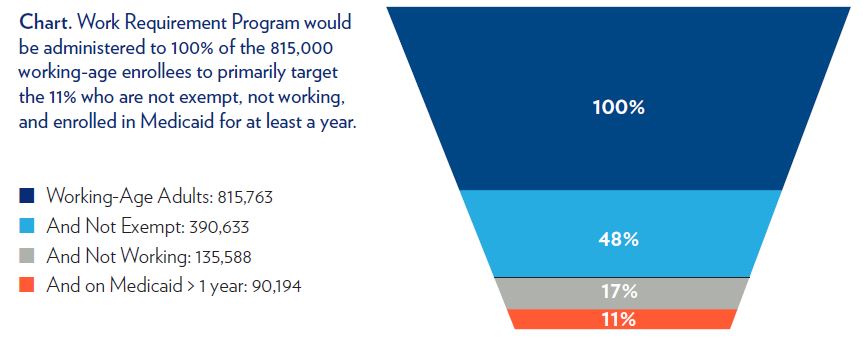Health Care Access & Coverage
Brief
Proposed Work Requirements in Pennsylvania Medicaid: Characterizing Eligible Beneficiaries
A report submitted to the Pennsylvania Department of Human Services

Executive Summary
To help the Pennsylvania Department of Human Services understand the likely impact of a proposed Medicaid work requirement, we analyzed the demographic, economic and health characteristics of working-age, non-disabled adults who receive Medicaid, and any issues or barriers this population may face in obtaining and maintaining employment.
Using information from all 2.9 million Medicaid enrollees as of April 1, 2016, we identified the 815,763 working-age adults (ages 21-64) and assessed their likely exemption and working status over the course of the subsequent year. More than half would likely be exempt from work requirements because of their caregiver status (38%) or disability status (14%). Thirty-one percent would be nonexempt but considered working, with at least one month of work; this group had either part-time or full time work 95% of the time they were enrolled in Medicaid. This snapshot suggests that more than 80% of working-age adults were already working or disabled or potential caregivers and thus, while still subject to compliance verification that the Department will need to administer and enforce, are unlikely to substantially benefit from work requirements. Our results, as visualized below, show that 11% (90,194) of working-age enrollees (815,763) subject to administration and verification of the work requirement program would be found to be nonexempt, not working and on Medicaid for at least a year. This group, representing just 3% of the 2.9 million Medicaid enrollees, would have the greatest potential to change their work status as a result of the program. The burden and cost of implementation to the 815,763 would have to be weighed against the benefit to the 90,194 to determine whether, among current beneficiaries, the benefits of such a program outweigh the costs.
To help the Department understand this target population of most likely program beneficiaries, we analyzed how demographic and health characteristics differ between working and nonworking enrollees. We find that many nonexempt, nonworking enrollees have characteristics that may pose barriers to finding and keeping a job. Forty-five percent of these nonworkers are over the age of 40; 25% are over 50. More than one-quarter of them have at least one chronic condition—not including substance use disorders. More than 20% have a substance use disorder. Compared to working enrollees, nonworking enrollees are more often older, male, in metro counties, and in single-person households. Nonworkers who stay on Medicaid for at least one year tend to be older and sicker than nonworkers with shorter stays on Medicaid. And a third of the nonworkers who are on Medicaid for a year leave the program in the subsequent year. Thus, this snapshot provides a glimpse into the characteristics of the likely target population that the Department would need to consider when first implementing a work requirement across all existing Medicaid enrollees.
